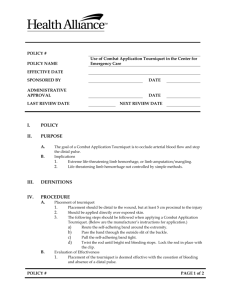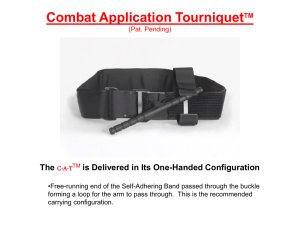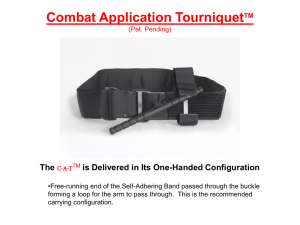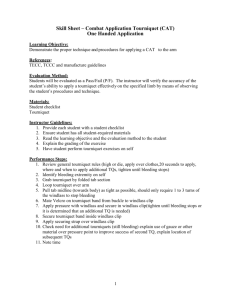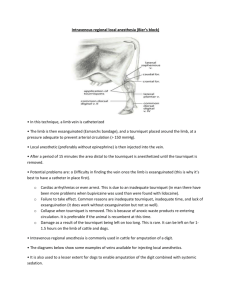Combat Application Tourniquet – Storage Configuration
advertisement
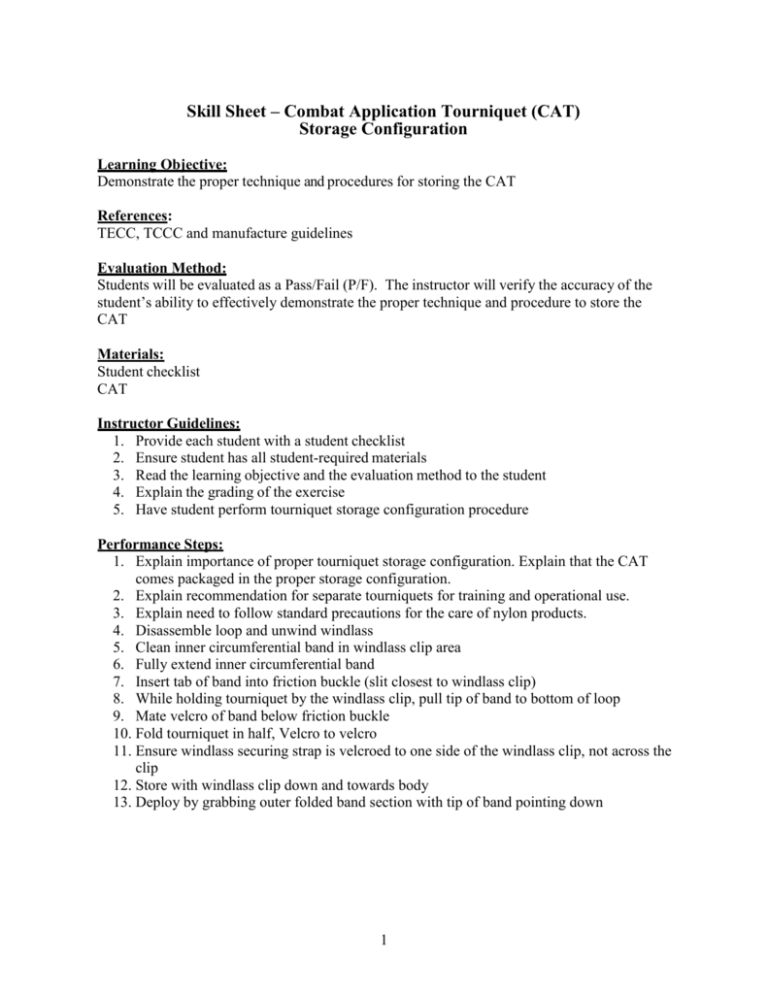
Skill Sheet – Combat Application Tourniquet (CAT) Storage Configuration Learning Objective: Demonstrate the proper technique and procedures for storing the CAT References: TECC, TCCC and manufacture guidelines Evaluation Method: Students will be evaluated as a Pass/Fail (P/F). The instructor will verify the accuracy of the student’s ability to effectively demonstrate the proper technique and procedure to store the CAT Materials: Student checklist CAT Instructor Guidelines: 1. Provide each student with a student checklist 2. Ensure student has all student-required materials 3. Read the learning objective and the evaluation method to the student 4. Explain the grading of the exercise 5. Have student perform tourniquet storage configuration procedure Performance Steps: 1. Explain importance of proper tourniquet storage configuration. Explain that the CAT comes packaged in the proper storage configuration. 2. Explain recommendation for separate tourniquets for training and operational use. 3. Explain need to follow standard precautions for the care of nylon products. 4. Disassemble loop and unwind windlass 5. Clean inner circumferential band in windlass clip area 6. Fully extend inner circumferential band 7. Insert tab of band into friction buckle (slit closest to windlass clip) 8. While holding tourniquet by the windlass clip, pull tip of band to bottom of loop 9. Mate velcro of band below friction buckle 10. Fold tourniquet in half, Velcro to velcro 11. Ensure windlass securing strap is velcroed to one side of the windlass clip, not across the clip 12. Store with windlass clip down and towards body 13. Deploy by grabbing outer folded band section with tip of band pointing down 1 Combat Application Tourniquet – Storage Configuration Task 1st 1. Explains importance of proper tourniquet storage configuration. Explains that the CAT comes packaged in the proper storage configuration. 2. Explains recommendation for separate tourniquets for training and operational use. 3. Explains need to follow standard precautions for the care of nylon products. 4. Disassembles loop and unwinds windlass 5. Clean inner circumferential band in windlass clip area 6. Fully extend inner circumferential band 7. Insert tip of band into one side of the friction buckle (slit closest to windlass clip) 8. While holding tourniquet by the windlass clip, pull tip of band to bottom of loop 9. Mate Velcro of band below friction buckle 10. Fold tourniquet in half 11. Ensure windlass securing strap is velcroed to one side of the windlass clip, not across the clip 12. Store with windlass clip down and towards body, flat nylon and tab pointing down away from the body 13. Deploy by grabbing outer folded band section with tip of band pointing down Overall Grade P / F P / F P / F P / F P / F P / F P / F P / F P / F P / F P / F P / F P / F P / F P / F P / F P / F P / F P / F P / F P / F P / F P / F P / F P / F P / F P / F P / F P / F P / F P / F P / F P / F P / F P / F P / F P / F P / F P / F P / F P / F Did not clean and extend inner circumferential band _____ Did not pass band through near slit of friction buckle Did not store windlass securing strap to one side of windlass clip 2 3rd P / F Critical Criteria: Evaluator’s Comments: Completed 2nd Notes: 1. This is the manufacturer’s recommended storage configuration. The key is that the user should be very familiar with the storage configuration and location of his/her tourniquet so it can be accessed and applied quickly and efficiently. Each officer should be certain that he/she can deploy his/her tourniquet rapidly, with one hand, and with the tab pointing inward when placed on a limb. 2. It is recommended that operational tourniquets not be used for training. Excessive use can stretch and weaken the nylon and degrade the Velcro adhering strength. At the end of the training day errors can also be made when re-configuring the tourniquet for storage which could cause delays in operational application when seconds matter. 3. Nylon is degraded by extended exposure to sunlight and chemicals. Avoid storing your tourniquet in an area exposed to direct sunlight or chemicals, i.e. front or rear dash of vehicle, in trunk or compartment where oil or gas is stored. 4. Nothing further 5. Nothing further 6. Nothing further 7. Nothing further 8. Nothing further 9. Nothing further 10. Prior to the fold, while holding the tourniquet loop by the clip, one side of the loop should be nylon and one side should be Velcro. When folding the tourniquet in half fold Velcro to Velcro. After the fold the tourniquet should have the windlass and clip on one side and flat nylon with the tab on the other side. 3
